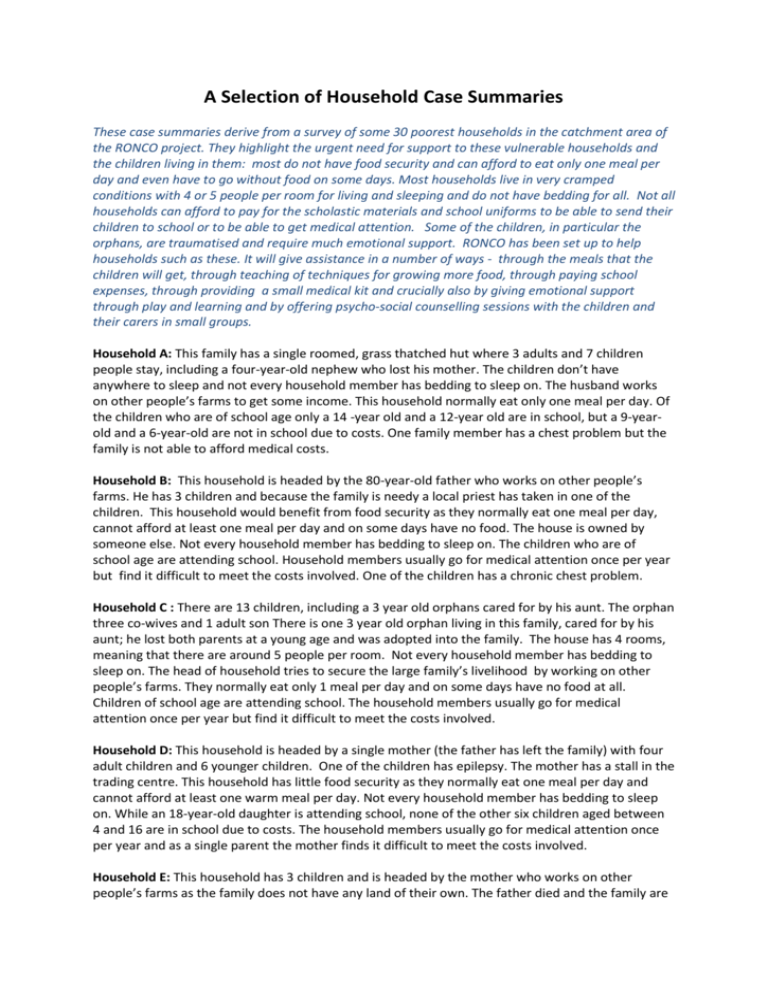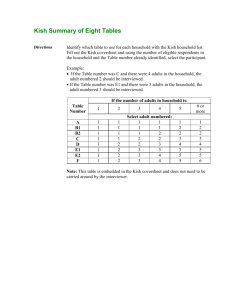A Selection of Household Case Summaries
advertisement

A Selection of Household Case Summaries These case summaries derive from a survey of some 30 poorest households in the catchment area of the RONCO project. They highlight the urgent need for support to these vulnerable households and the children living in them: most do not have food security and can afford to eat only one meal per day and even have to go without food on some days. Most households live in very cramped conditions with 4 or 5 people per room for living and sleeping and do not have bedding for all. Not all households can afford to pay for the scholastic materials and school uniforms to be able to send their children to school or to be able to get medical attention. Some of the children, in particular the orphans, are traumatised and require much emotional support. RONCO has been set up to help households such as these. It will give assistance in a number of ways - through the meals that the children will get, through teaching of techniques for growing more food, through paying school expenses, through providing a small medical kit and crucially also by giving emotional support through play and learning and by offering psycho-social counselling sessions with the children and their carers in small groups. Household A: This family has a single roomed, grass thatched hut where 3 adults and 7 children people stay, including a four-year-old nephew who lost his mother. The children don’t have anywhere to sleep and not every household member has bedding to sleep on. The husband works on other people’s farms to get some income. This household normally eat only one meal per day. Of the children who are of school age only a 14 -year old and a 12-year old are in school, but a 9-yearold and a 6-year-old are not in school due to costs. One family member has a chest problem but the family is not able to afford medical costs. Household B: This household is headed by the 80-year-old father who works on other people’s farms. He has 3 children and because the family is needy a local priest has taken in one of the children. This household would benefit from food security as they normally eat one meal per day, cannot afford at least one meal per day and on some days have no food. The house is owned by someone else. Not every household member has bedding to sleep on. The children who are of school age are attending school. Household members usually go for medical attention once per year but find it difficult to meet the costs involved. One of the children has a chronic chest problem. Household C : There are 13 children, including a 3 year old orphans cared for by his aunt. The orphan three co-wives and 1 adult son There is one 3 year old orphan living in this family, cared for by his aunt; he lost both parents at a young age and was adopted into the family. The house has 4 rooms, meaning that there are around 5 people per room. Not every household member has bedding to sleep on. The head of household tries to secure the large family’s livelihood by working on other people’s farms. They normally eat only 1 meal per day and on some days have no food at all. Children of school age are attending school. The household members usually go for medical attention once per year but find it difficult to meet the costs involved. Household D: This household is headed by a single mother (the father has left the family) with four adult children and 6 younger children. One of the children has epilepsy. The mother has a stall in the trading centre. This household has little food security as they normally eat one meal per day and cannot afford at least one warm meal per day. Not every household member has bedding to sleep on. While an 18-year-old daughter is attending school, none of the other six children aged between 4 and 16 are in school due to costs. The household members usually go for medical attention once per year and as a single parent the mother finds it difficult to meet the costs involved. Household E: This household has 3 children and is headed by the mother who works on other people’s farms as the family does not have any land of their own. The father died and the family are reliant on a good Samaritan who has given them a house to stay in. This family cannot afford to have at least one warm meal per day regularly, on some days they have no food at all. The family go for medical attention 3 or more times per year but cannot afford the medical costs involved. Household F: This household has a mother who works on other people’s farms, father who has a small shop in the trading centre; there are five children. The house has 2 rooms so there are over 3 people per room. The mother is ill and the family sometimes has to ask others for handouts. The children who are of age are attending school. The family normally eat one meal per day and cannot afford at least one warm meal per day. This family usually goes for medical attention twice per year but find it very difficult to meet the medical costs. Household G: .This family of two adults and 5 children and lives in a one roomed house. The husband works on other people’s farms. The family does not own the house it lives in and not every household member has bedding to sleep on. While a 13-year-old child attends school, he doesn’t have school uniform, and is without books and pens at school. The other children of school age, a 9year old and a 6-year old are not in education due to the costs involved. This household has little food security as they normally eat only one meal per day, cannot afford at least one meal per day and on some days have no food. The family goes for medical attention once a year and is not able to afford medical costs. Household I: This family is headed by the mother, with 2 adult children and 3 younger children. The father died of HIV/AIDS. The mother also has HIV and is taking antiretroviral drugs. She works on other people’s farms as the family has no land. Not every household member has bedding to sleep on. This household may benefit from food security as they normally eat only one meal per day and cannot afford to have one warm meal per day. The children who are of age are attending school. The family usually goes for medical attention twice per year, but finds it hard to meet the costs. Household J: This household includes two parents, 2 adult children and 6 younger children. The house has two rooms so there are 5 persons per room. The father fetches water or does weeding to get an income. The mother has chronic problems with swollen legs which makes it difficult for her to work. Not every household member has bedding to sleep on. Only two of the children of school age are in school, because the family cannot afford the costs involved. This household’s food security is very precarious; they normally eat one meal per day, cannot afford at least one meal per day and on some days have no food. The household members usually go for medical attention once per year and find it difficult to meet the costs involved. Household K: This household is headed by a single father with three children (a daughter and two grand children). One of the grand children has lost both parents. The house is grass thatched and looks unstable. Not every household member has bedding to sleep on. The father has a paralysed arm which makes it difficult to work. A 16 year old and a 6 year old are not in school due to cost. This household has little food security – they eat one meal per day, cannot afford at least one meal per day and on some days have no food. They go for medical attention once per year and are not able to afford medical costs. Household L: In this household there is a mother and three children. The father died of an accident and the children are finding it difficult to deal with trauma surrounding their dad’s death. The mother works on other people’s farms. The single-roomed house is owned by the mother-in-law. Not every household member has bedding to sleep on. The children who are of age are attending school. The household eats two meals per day and go for medical attention once per year, but are not able to afford medical costs.







